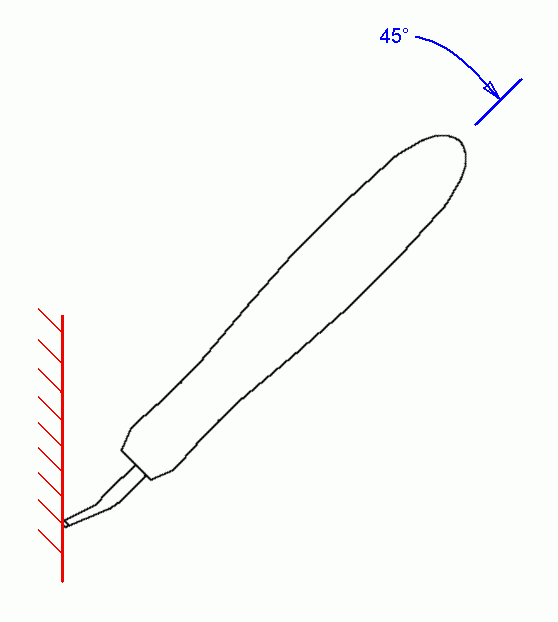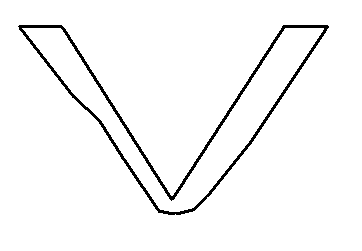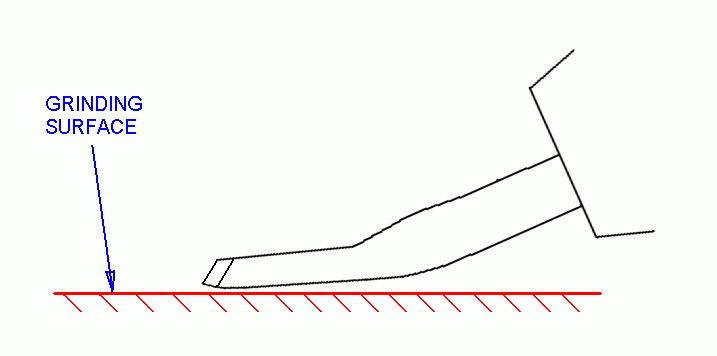GOUGE MODIFICATION - REVERSAL
There are three popular modifications made to carving gouges:
Pinching, reversing, and miniaturization. On this page I will
discuss reversal.
The carving edge of a properly-formed V-gouge is
a flat V facing directly away from the handle. Since you carve
with the handle angled down toward the rubber, this carving edge leans
forward and the top corners of the V are out over the area you are
trying to carve. To some carvers, this doesn't make any
sense. It makes more sense that the angle of that cutting edge be
reversed, that it lays back toward the handle out of your line of
sight. This is the idea behind the reversed gouge.
It must be noted, however, that there's a very good reason that gouges
are shaped the way they are. With the standard configuation, the
gouge will cut smoothly and controllably at any depth up to the point
where the top corners of the tip get buried. Once a gouge is
reversed, this is no longer the case. With a reversed gouge you
can readily cut
very tiny details, but carving deeper doesn't work as well. The
gouge
will have a tendency to "dig in" and start cutting deeper than you
want. With care it can still be used to cut deep grooves, but
it's
definitely not as smooth and controllable in deep cuts as the
unmodified gouge is. For most carvers, it would be a good idea to
keep a regular 1V on hand and only reverse a second or spare gouge.
Many carvers have purchased the Staedtler package and hence have a 1V,
2V, and 5U on hand -- and rarely use the last two. Good
news: You can reverse the 2V just as easily as a 1V, and the
finished product works every bit as well. In fact, if you have a
2V laying around, that's the gouge I recommend you reverse. The
end result looks a bit different than a reversed 1V, but it works
fine. The illustrations in the following process show a 1V, but
the method of reversing is exactly the same.
When reversing, the condition of the original tip matters not a whit,
you're about to hack it off. Hence, if you have a gouge with a
deformed or damaged tip, it's a fine candidate for reversing.
Step 1: Hold the gouge with the handle at a 45° angle to the
grinding surface and the top of the gouge facing the grinding surface,
as shown.

While holding this position, grind the top corners off the tip and
continue grinding until you can look at the shiny spot formed and see a
complete V. This is one place where a power grinder comes in
handy, but this task can still be done by hand in only a matter of
minutes. If using a bench grinder, you will need
to stop several times and dunk the tip in cool water to keep it from
overheating.
The instructions for the rest of the reversing process look remarkably
similar to the cleanup of a normal gouge described on the sharpening
page. The only difference, really, is that everything is done to
a tip that is angled differently.
As mentioned above, you need to continue the
grinding until the shiny area forms a complete V. Don't go
overboard and try to make it a pretty or uniform V, only go far enough
that there
are no gaps in the V. It will probably look something like this:

Now, for Step 2 you will grind
the outside along one side of that V parallel to the inside surface of the tip:
You need to know more than this illustration shows, though; you need to
know how steep to make that cut. The best way I can describe it
is: With the side of the tip against the grinding surface, the
butt end of the handle should be about 2" to 2-1/2" above the grinding
surface.
This is presuming a Staedtler handle, which is about 6" long overall.
Don't try to grind the side of the gouge all the way to a sharp edge
just yet. For one thing, if you're using a powered grinder,
you'll probably burn the metal; the thinner the edge gets, the
easier it is to overheat it. For now, just put a nice bevel on
the outside surface of the gouge while leaving a narrow band of the
original shiny surface remaining.
Now, obviously, flip it over and do the other side the same way:
When you're done with these flats, the gouge viewed from the side
should have a flat that looks like this:
Note that if the ground surface isn't shaped pretty much like that, you
probably did something wrong.
Next, hold the gouge right side up with the bottom of the nib against
the grinding surface, with the end of the gouge almost flat against the
surface -- just slightly nose-down, so the tip contacts first.

While holding this position, grind just enough to create a flat on the
bottom that is shaped like an elongated diamond. Do not, repeat DO NOT grind enough that you break
through to the inside of the V at the tip! You want to grind
until the elongated diamond you are creating extends right up to
the front of the nib, though, where the two sides you ground meet at
the bottom of the V. This grind is more critical on a reversed
gouge than on a regular gouge because the point of that V is the only
reason a reversed gouge can cut at all. If it doesn't cut right
when done, an inspection with a 10X magnifier usually reveals that the
tip comes to a point below the bottom of the V rather than right at
it. Grind a bit more, preferably by hand, bringing the end of
that elongated diamond right up close to the inside surface at the
bottom of the V without breaking
into it. If you break into the inside surface, you'll have
to grind the tip back to clean up the break and start over with the
grinding and sharpening.
Note: Both Staedtler and Speedball nibs come with the bottom
ground to a rounded shape. I have
tried both ways, with a flat bottom and with a rounded bottom, and in
my opinion the flat bottom works as well or even slightly better; the
gouge has less tendency to fall into the groove you just cut.
It's also much easier to grind a flat than a curved surface. You
may, however, opt to roll the gouge side-to-side during this step to
round the bottom if you prefer.
SHARPENING: Hold the
gouge with the tip against the surface of the hone and rolled onto one
side, so that one side of the V is flat against the hone. The tip
of the handle should be perhaps 2-1/2" to 3" above the honing surface,
which you'll note is a bit higher than it was held in the grinding
steps described above. This will have you honing just at the
cutting edge rather that trying to move the entire bevelled surface.
The trick here is to have good light and good magnification to see what
you're doing, and hold the gouge in one hand and the hone in the
other. Firmly establish the position that you will be holding
both. Bring them together and begin a honing motion (back and
forth, circles, doesn't matter much) without changing those
positions. Periodically stop and look at the polished area you
have created, making sure that it is uniform along the edge and not
concentrating too much at one corner or the
other. If you find you've been leaning a bit crooked one way or
the other, adjust and continue.
Now is the time to
bring that
bevelled surface all the way to meet the inside surface of the V.
Note that as you get close to the inside surface of the V you need to
be applying only very light pressure on the hone. Too much
pressure will push the thin edge right over. Even if it doesn't
permanently deform it, it can bend it enough that the hone isn't
creating the edge you're looking for; it's not polishing the edge
itself because the edge has moved out of the way. Very light
pressure is the secret to success here; let the hone and the motion do
the work, don't try to rush it or force it.
Note: If you have experience sharpening knives, you're probably
alarmed at how steep these angles are. If you honed a knife at
similar angles, it would end up with a pretty blunt edge indeed and
wouldn't cut well at all.
If you try to use the shallow angles commonly used in knife sharpening
on a gouge, you'd end up with a very sharp gouge -- and you'd
bend the edge over as soon as you tried to carve with it. The
cutting
edge on a gouge nib needs to have comparatively blunt angles to
be strong enough to push into rubber and pry pieces out without getting
damaged. The fact that the tip doesn't have that razor sharpness
you get from honing at shallow angles isn't a problem because it's not
difficult to push a gouge through rubber anyway.
Obviously, once done with one side of the V, roll the gouge the other
way and do the other side.
Once you have both sides honed to form an actual cutting edge at the
face of the V, you will know perfectly well how to hold the gouge with
one side or the other against the hone while rubbing. Now do one
more trick: While holding one side of the gouge against the hone
and rubbing, slowly roll the gouge over to the other side, continuing
the honing motion all the way. Keep the handle at about the same
height through this process. When honing a Staedtler, the entire
roll should take no more
than a few seconds; it takes a bit longer on a Speedball because the
bottom of the V isn't as crisply formed. When done, you can look
at the bottom of the
V and see what you've done. This step will round the corners
where the flats on the sides and the elongated diamond flat on the
bottom meet.
This is a more critical step on a reversed gouge than on a regular
gouge. If the gouge doesn't want to cut when done, the first step
might be to repeat this process while watching the point with a 10X
magnifier. Ideally, the gouge should have a sharp cutting edge
all the way around the inner surface of the V and all metal should
angle back toward the handle from there. If there is any metal
that juts out forward of the inner edge of the tip, it needs to be
ground off.
The next step is to take your ceramic knife and position the edge of
the knife down in the bottom of the V. The tip of the knife
should be pointing toward the handle of the gouge. With the
ceramic knife held in this position, roll it until one side of the
knife is sitting flat against one side of the V of the gouge.
Slide
the knife in and out of the tip of the gouge a couple of times; the
blade will probably come close to contacting the handle of the
gouge. You may notice a gray smudge appearing on the white
ceramic knife; that's metal particles being rubbed away. Roll the
knife over the other way and polish the other
side of the V the same way. And, just for good measure, stand the
ceramic knife up straight, centered between the two sides of the V, and
make a few more in-and-out sliding motions with the sharp edge of the
knife working on the bottom of the V only.
This treatment with the ceramic knife only takes ten seconds or
so. Two or three slides each way is plenty. It absolutely
must be the last thing done
to the cutting edge of the gouge, though. If you decide the work
on the outside isn't
quite right and you want to go back and hit it some more, be sure to
repeat the inside honing with the ceramic knife when you're done.
At this point on the sharpening of a regular or miniaturized 1V it was
suggested to make a "minor gouge modification" that involved grinding
the sides off the tip to improve visibility. That same
modification would be pointless on a reversed gouge, as the entire tip
is out of your line of vision. Just go ahead and try it out,
you're done.

